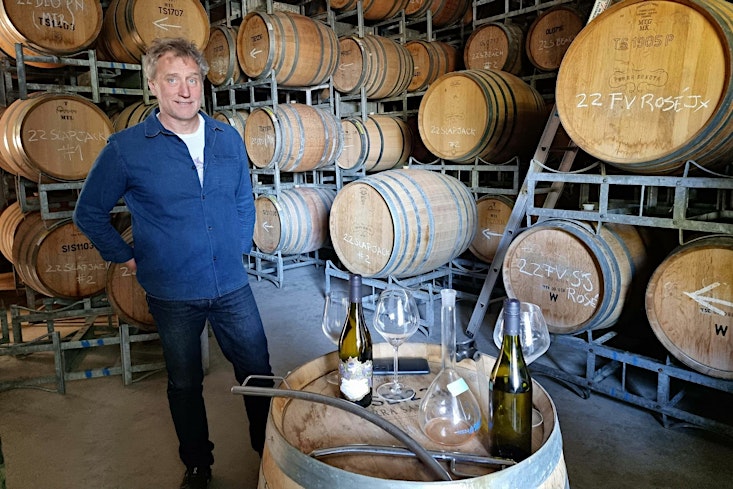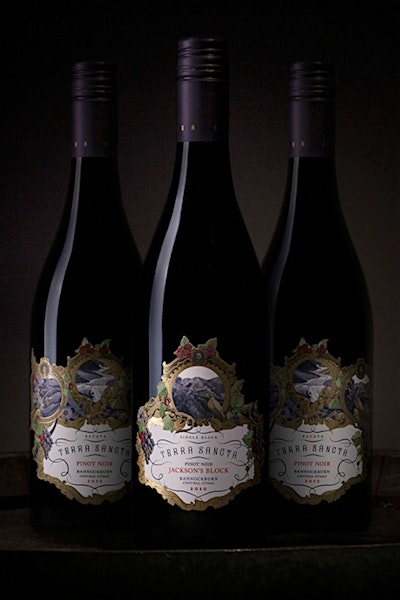Experience
Terra Sancta founder sits down with Bob Campbell from The Real Review

An Interview
With Bob Campbell from The Real Review
This article was originally published on The Real Review.
Mark and Sarah Weldon, proprietors of Terra Sancta, jumped in the deep end when they purchased their Bannockburn vineyards and built a winery. They successfully scaled a steep learning curve in a relatively short space of time, thawing an initial frosty reception from neighbours in the process.
Bob Campbell MW: When did you first consider buying a winery and what motivated you to make the move?
Mark Weldon: We started looking in 2009, and purchased the Bannockburn vineyards that became Terra Sancta in 2011. There was a sense of adventure, and a desire to make something tangible and lasting such that, if it all went well, it would provide a lot of pleasure for people, and meaning for us.
BC: What inspired you to choose Bannockburn?
MW: We believe in, and are passionate about Bannockburn. We looked throughout New Zealand – and one bit of advice we kept getting was ‘Get the best bit of dirt that you can because you can’t outperform the vineyard’. These were wise words which we took to heart. While New Zealand does not have a grand cru system, we formed the view that the land in New Zealand most likely to become one of the great terroirs in the world was in Bannockburn. We also love being nestled between the Kawarau River in front and the mountains behind. It’s a magical place.

BC: Why ‘Terra Sancta’?
MW: When we were looking out our first vineyard in Bannockburn, on Felton Road, a phrase kept coming up when we asked industry leaders about the vineyard. People from Ross Spence to Jim Delegat all said ‘That’s a very special place’. Roughly translated, terra sancta means ‘sacred earth— special place’. Terra Sancta is a joy to be at. We have our own flock of Baby Doll sheep that fertilise the soil, hens that aerate the soil and provide the team with amazing omelettes, and we practise organics without cultivation—keeping the carbon in the soil. This feels right to us and, along with our historic cellar door, we feel that after 11 years the name and the reality are pretty close.
BC: The vineyard you purchased had some of Central Otago’s oldest vines, many on their own roots. It must have been tough deciding which should stay and which should go?
MW: We have the oldest vineyard and first planted vines in Bannockburn, planted in 1991. The own-rooted vines we did pull out were the ones that we didn’t believe would ever make great wine in our site—pinotage, cabernet, syrah and sauvignon blanc. With respect to pinot noir, we kept all 13 hectares of original rootstock vines. We are fastidious about biosecurity. It still keeps us up at night, but so far—11 years in and with vines that are now 31 years old—we are happy with the decision, and love the purity of fruit that these old, own- rooted vines deliver. It’s unique.
BC: What do you enjoy most about being a winemaker?
MW: From the farming to the blending to the bottling, we do everything on-site at Terra Sancta, so when the team involved finally gets to taste the finished wine before it is released—well, there is something very special and satisfying about that.
BC: And least?
MW: Freezing winters. Admin. Dealing with Houdini-like Baby Doll rams chasing ewes on heat!
BC: You faced a steep learning curve. Did you get much help from your neighbours?
MW: It would be fair to say that our initial ‘welcome to the neighbourhood’ was about as frosty as a Bannockburn winter morning! I’d say we were assessed as being yet one more in a procession of ‘here today, gone tomorrow’ dabblers. There are so many stories which for the sake of neighbourly relations we won’t tell! Well…maybe one neighbour texting a threat to shoot our wandering pet goat and turn it into curry will give you a flavour! But once we did the hard yards, made some wines that earned respect and were visible on the farm, our neighbourly relations warmed up. They’re now great. We work together on pain points like water, and all help out in a pinch. To prove how great the relationships now are, we named our cutest Baby Doll sheep after Robin Dicey, our once grumpy but now favourite neighbour (and founder of Mt Difficulty!)

BC: Terra Sancta has earned many accolades. What do medals and trophies mean to you?
MW: High scores and trophies help retailers and the public have confidence in your brand, so they are important. They can also provide ‘pinch yourself’ moments, for instance being named in Wine & Spirit’s Top 100 Wineries in the World and being shortlisted for New Zealand Wine Producer of the Year at the International Wine and Spirits Competition.
Getting great scores from the independent, non-paid wine writers (Bob Campbell and Michael Cooper in particular), provide a great year by year reference point and are very meaningful. Accolades are always a boost to the team, and give a real sense of pride. They are also an opportunity for an exceptionally buoyant Friday afternoon mystery wine tasting (a Terra Sancta ritual)!
BC: You have a very distinctive and unique label. Where did the concept come from?
MW: We love old maps—they combine geography, science, art, and some mystery. A lot like wine. We have an antique map at our cellar door from the world’s first atlas (1582) of Terra Sancta (Holy Land). In the top right-hand corner of that map there is a cartouche, which visually tells the story of the place depicted in the map. We used the concept of a cartouche for our label—with our label designed to tell the story of our place and the wine in the bottle. Everything depicted, from the colours to the symbols, is connected to our vineyard and is a part of the story. Purple is the colour of the wild thyme on the vineyard. Gold represents the gold sluicings on Felton Road. The dog is our dog Miro, and the hawk presides over Lola’s Block. The fruits and flowers show characteristics found in our wines. The three circles represent our three single-block pinot noirs. Our labels are also a symbol of our dedication to detail, craft and care.
BC: If you had the chance to start again is there anything you would do differently?
MW: The easy answer is that we would have bought more Bannockburn land before the billionaires started moving in and pushed land prices out of reach!
Inside the business there have been a lot of mess-ups, to be sure. Farming can be ruthless— nature bats last! In the vineyard one year we lost control of the cover crops and yields really suffered. But we learnt from that, brought in some new kit from Germany, and are now really proud of being a no-tillage organic farm. From each mistake we have learnt something, so they have been pretty valuable although painful at the time.
BC: What is your greatest achievement as a winemaker?
MW: Our no-till regenerative agriculture organics program. It’s been a journey to get here We are at a point now that the health of our vineyard means that this year, for example, all of our wines— from Mysterious Diggings Pinot Noir to Slapjack Block Pinot Noir and our rosé—are all 100% native ferment (with not a single stuck ferment). We have such good natural balance from the vineyard that there is zero acidification, no additives, and we have not filtered a red wine since 2016. Basically, we make natural wines, without calling them that on our label. We think each wine shows the vitality of our vineyard and we are really proud of that.